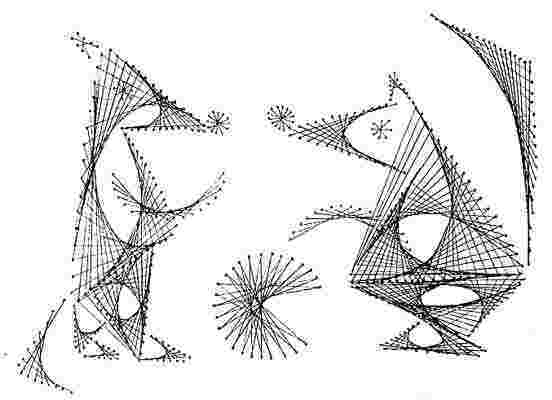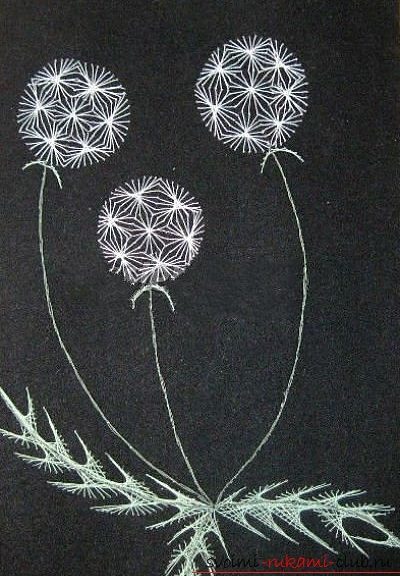
A simple and detailed master-class on work in technology is "isolate" for those who only make the first steps in this kind of needlework.
In recent years, great popularityvarious kinds of arts and crafts, having received the newfangled name "hand-made". Among the most common are: soap making, beadwork, origami, scrapbooking, decoupage on fabrics and many other techniques of needlework. All of them develop imagination, horizons and imagination, finger motility, assiduity, so they are shown for adults and children, and for people of all ages with various disabilities. In addition, such activities will be a wonderful joint pastime of all family members. 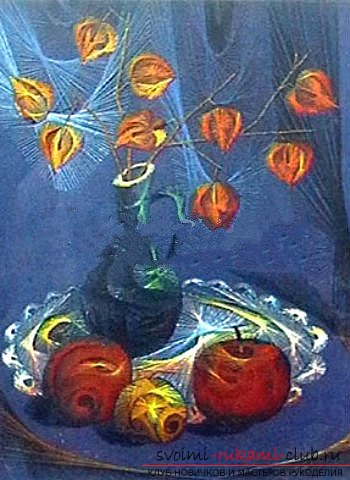 Products in the technique of "isolate" are also thosethe most "beautiful", which in the end will save the world. To outline schemes for beginners, the technique in which it is shown is very accessible and, as a consequence, suitable for people who want to learn the basics of this art, and for those who want to "get into the heart of the matter." For those who only get acquainted with this technique I want to say the following: Izonit is one of the types of decorative and applied art that can be attributed and "put" at the origins of the folk crafts of England. It was the English weavers who became the founders of the new way of thread interlacing, thanks to which light and airy delicate products for dwellings were obtained. Over the years, this technology has been improved, today its stages involve piercing holes on cardboard or other very dense paper, through which a thread is threaded in a special way, as a result of which it is possible to obtain a work of art (panels, pictures, etc.).
Products in the technique of "isolate" are also thosethe most "beautiful", which in the end will save the world. To outline schemes for beginners, the technique in which it is shown is very accessible and, as a consequence, suitable for people who want to learn the basics of this art, and for those who want to "get into the heart of the matter." For those who only get acquainted with this technique I want to say the following: Izonit is one of the types of decorative and applied art that can be attributed and "put" at the origins of the folk crafts of England. It was the English weavers who became the founders of the new way of thread interlacing, thanks to which light and airy delicate products for dwellings were obtained. Over the years, this technology has been improved, today its stages involve piercing holes on cardboard or other very dense paper, through which a thread is threaded in a special way, as a result of which it is possible to obtain a work of art (panels, pictures, etc.). 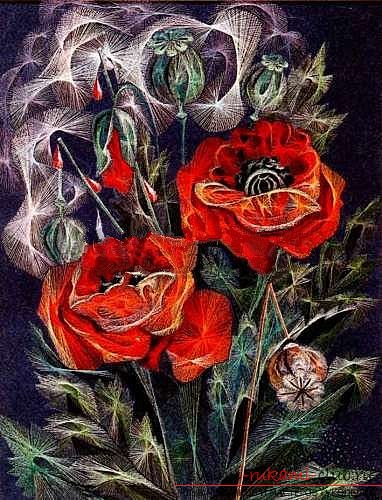 Materials for the manufacture of hand-made articles in the technique of "isolate":
Materials for the manufacture of hand-made articles in the technique of "isolate":
- Cardboard or thick velvet paper (the latter is best used in the presence of skills, since it is much thinner than cardboard, so it is best to use needlewomen with experience);
- Silo or English needle (required for piercing holes);
- Threads such as "mulina" or "iris" (the work will belook more beautiful, if you use glossy yarns or thin lurex for work, also good work with threads with the transition of color from darker to lighter scale. It should be noted that woolen threads or with a high content of mohair or angora are categorically not suitable for needlework on isonite, nor are conventional reel threads suitable, since they are dull, so it is best to train and acquire skills);
- Scissors;
- Scotch tape, glue;
- Needle with an ear of medium size;
- Polyfoam (can be foam rubber).
Schemes for beginners, as well as videos in whichthey will tell you in detail about the technology of making pictures from the beginning to the end, they are widely represented on the Internet, besides today a sufficient number of books with a detailed description are produced. The technique is possible thanks to two techniques: the execution of a circle and an angle, following the direction indicated in the diagrams. Color schemes in the technology to isolate for beginners decorate any picture or cards with their own hands - to isolate, a master class with step-by-step photos of which can easily be found on our website. To mend the schemes for beginners - the technique of the flower "Dandelion": On the base sheet (which also acts as a background), draw a circle with the help of a circular, the circumference of which is divided into sixteen equal parts. The easiest way to do this is as follows: first circle through the center split in half, then divide each half exactly in half, then each formed part in half, you need to do this until you get sixteen parts. Under the base to put foam or foam, do holes. 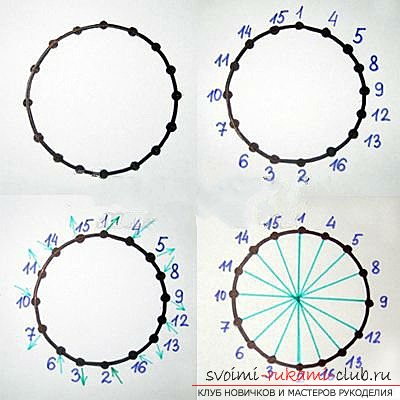 From the wrong side, assign each holenumber (there will be 16, respectively). Further as shown in the photo, isolate the circuits for beginners located below threading. Continue this need around the whole circumference, not missing a single hole. Advice: in order that the thread is not confused and nodules are not formed, they should be measured in medium length. If the thread is still entangled, it should be pulled back, trying to dissolve. At the very beginning and at the very end of the work, the ends of the threads should be fixed by gluing to the base.
From the wrong side, assign each holenumber (there will be 16, respectively). Further as shown in the photo, isolate the circuits for beginners located below threading. Continue this need around the whole circumference, not missing a single hole. Advice: in order that the thread is not confused and nodules are not formed, they should be measured in medium length. If the thread is still entangled, it should be pulled back, trying to dissolve. At the very beginning and at the very end of the work, the ends of the threads should be fixed by gluing to the base.  Angle, it's the same sheet we can get the followingway: draw an angle, divide it into several equal parts, number them, embroider on the same principle as the circle, that is, threading in the directions indicated in the diagram.
Angle, it's the same sheet we can get the followingway: draw an angle, divide it into several equal parts, number them, embroider on the same principle as the circle, that is, threading in the directions indicated in the diagram. 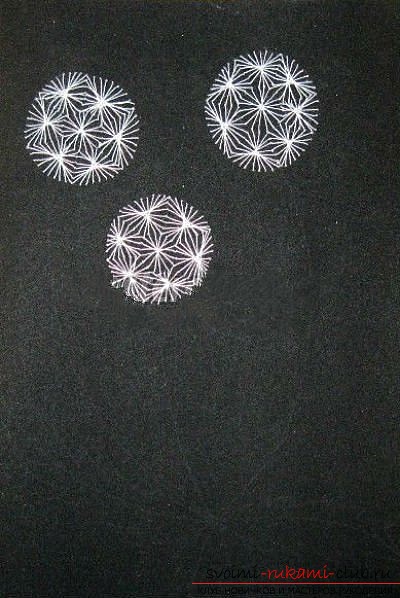 And, the balls of dandelions in will be fulfilledwhite threads, leaves, respectively - green, the background is suitable cardboard more light green, blue or yellow, more expressive will be a dark color, for example, black. You can complement the flowers with weed, butterflies and so on. Cut thread threads from the wrong side with adhesive tape or glue. The finished drawing is best placed in a frame, after which it can be hung on the wall, decorating the house, or present as a present to a friend, mother, grandmother. For a father, a friend, a grandfather or a colleague, it is possible to present them with a picture of a sailboat, horse or other neutral topics on a tree.
And, the balls of dandelions in will be fulfilledwhite threads, leaves, respectively - green, the background is suitable cardboard more light green, blue or yellow, more expressive will be a dark color, for example, black. You can complement the flowers with weed, butterflies and so on. Cut thread threads from the wrong side with adhesive tape or glue. The finished drawing is best placed in a frame, after which it can be hung on the wall, decorating the house, or present as a present to a friend, mother, grandmother. For a father, a friend, a grandfather or a colleague, it is possible to present them with a picture of a sailboat, horse or other neutral topics on a tree. 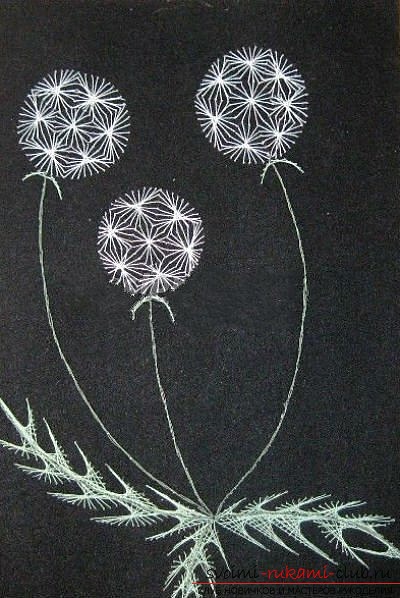 I would like to note that the technique isbeginners can be slightly changed, for this to velvet paper or cardboard (also this technique is suitable for wood isonite, only need not to use buttons, but small carnations, nailed according to the same scheme) you need to sew buttons "on a leg", decorated with bugles - they can also become the main decoration of the picture or postcard. Inspiration to you and good luck!
I would like to note that the technique isbeginners can be slightly changed, for this to velvet paper or cardboard (also this technique is suitable for wood isonite, only need not to use buttons, but small carnations, nailed according to the same scheme) you need to sew buttons "on a leg", decorated with bugles - they can also become the main decoration of the picture or postcard. Inspiration to you and good luck!


